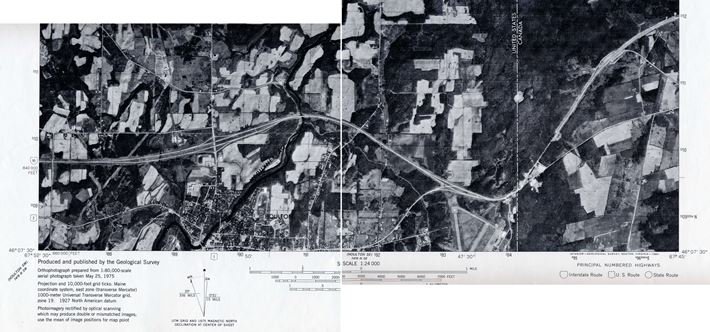"An Unfortunate Mishap": The Official Account of Three Cape Breton Deaths
Forty-eight years ago today, July 10, 1970, at seven in the morning, a freight train approaching Timony Crossing, in Aroostook County, Maine, sounded its horn. A little distance ahead, three Cape Breton boys lay motionless on the tracks. The train descended into a deep ledge cut, the roar of the wheels projected by the steep banks, but the boys, it would be said, were sleeping so soundly that the horn and the noise of the train and the vibrations of the tracks did not wake them.
When the sun had begin to rise over Smyrna Mills at ten to five that Friday morning, no one woke. Even two hours after daybreak, not one of the boys had gotten up, perhaps to relieve himself, or just stretch after hours lying on the rough rubble. If one had gotten up, he would have laughed and shook his head, and told the others to wake up and get off the track, but he hadn't. Not even two hours and ten minutes after sunrise did one wake. There was not a restless sleeper among the three of them.
Travelling at 40 miles per hour, the train emerged from the hollow and rounded a sharp turn. The engineer sighted debris on the track, one hundred and fifty feet away. He started to slow the train down. Then the engineer saw it was sleeping bags, and he locked the wheels of the train. As the train bore down on the boys, its wheels screeching and horn blasting, the three still did not wake, did not make a movement, and the engine and the nineteen freight cars it was hauling rode over them, mangling and crushing their bodies, and the last car continued on about fifty feet past them before coming to a complete stop.
Local police from the Aroostook County Sheriff's Department soon arrived at the location. Sheriff Darrell Crandall and Deputy Sheriffs Russell Socoby and Glen Philbrick saw at once that this was an accident and that the boys had been sleeping and that they had died in their sleeping bags, under the wheels of the train. They were fast workers at the Aroostook County Sheriff's Department.
At first, it is true, the officers were “puzzled by the men sleeping on railway tracks,” but they promptly solved that mystery. Somewhere “in the Smyrna area,” it was recalled, “it had rained sometime during the day before” – true, only a shower, but “a heavy shower” -- and the investigators reasoned that when the trio “bedded down” after midnight, early Friday, it might have been drier on the train tracks than on the ground next to the tracks, so the three had probably decided to sleep on the tracks to stay dry.
And not only that, but the rain from that same “heavy shower,” somewhere in the area, sometime “the day before,” explained why all three had slept so long past daybreak and weren't woken by the approaching train. The boys, the “officials theorized . . . pulled the sleeping bags over their heads to keep the rain off.” It was a busy shower, that shower from the day before, that was now falling the next day, when the boys went to sleep on the train tracks after midnight.
Only professional investigators with years of experience could have concluded the case so quickly. It was a morning's work for these men, but speed was of the essence. The Sheriff’s Department had to establish the proper story so that after lunch the Sheriff could get on the phone with the press, ruling out even the possibility of foul play and declaring the incident “an unfortunate mishap.”
And later that day, Sheriff Crandall would indeed be on the phone explaining to busily scribbling reporters in Maine and Nova Scotia that with the boys sleeping on the tracks with sleeping bags over their three heads, they wouldn't necessarily be woken by 130 minutes of sunlight or the freight train approaching, even when it was charging down on the boys fifty feet away, forty feet away, thirty feet away, with the train wheels screeching and the horn blasting and the rails shaking. The boys were sleeping soundly and dry as toast. The case was solved. Sheriff Crandall said that his report “would stress that there was no foul play.” Till the autopsy report was delivered, the case couldn't be closed – but it was, as of now, Friday afternoon, solved.
What made the accomplishment especially impressive was that Friday morning they didn’t even know who the victims were, since the three boys were found without any ID on them, not one piece. But because of the Canadian canned goods and cigarette packs scattered around the area, the investigators immediately knew that these long-haired youngsters were not local boys, not even Americans. They were Canadians, and now the priority of the local police was to ship the bodies back to Canada fast, preferably starting the day after tomorrow – and, on schedule, they would accomplish just that.
Luckily, for the purposes of the Aroostook Sheriff Department, one of the three, the oldest, had his name and address in Sydney, Nova Scotia, on his sleeping bag. So the Department contacted, through the RCMP, the police in Cape Breton and it was established that the three were Terry Burt (20) of Sydney, and Kenny Novak (15) and David Burroughs (17) of Sydney River. So now all that was required was for the fathers to make the journey to Maine and officially identify their children – which was done Sunday afternoon – and the bodies could then be prepared to be shipped north, back across the Canada-United States border.
THE NEXT MORNING this “tragic train accident” was reported on page three of Saturday's Cape Breton Post, the local news section. For the Canadian youth were from industrial Cape Breton, which was crisscrossed with railway tracks, and where the trains ran day and night. Every day the boys, as they sat waiting in a car or standing on the side of the road, would have watched, close up, these trains ride past them. All three knew the terrible damage a train could inflict on the human body; they knew of people in Cape Breton who had died in train accidents, and they saw people who had lost limbs in train accidents.
Even so, three Cape Breton boys had chosen to sleep on train tracks. Chose not only to sleep on a railway line, but to do so just beyond a sharp turn in the tracks, which meant “there was no way possible” for the freight train to avoid running over them and destroying their bodies.
No wonder a rumour eventually began that the three had formed a suicide pact. Now that was nonsense, but there had to be some explanation for the boys' behaviour, and once the Sheriff ruled out foul play – as “far-fetched,” mind you – the “tragic accident” account of events was immediately reported as an established fact, the Sheriff's version of reality like the reading on a thermometer telling the temperature, and you couldn't question the thermometer or the Sheriff, because they were the official and, in the Sheriff's case, moral standard, and didn't you see it in the paper, anyway, an empirical fact: NO FOUL PLAY. But still it just didn't make sense that three Cape Breton boys would decide to go to sleep on train tracks and then, though sober and drug-free, as the autopsy found, not wake up. If they were not murdered, some people asked, what else then could it be but suicide?
But, I remember, we teenage friends of the victims had a lot more pertinent questions about this strange new fact in the universe, the “tragic accident” established by the police and press, the arbiters of adult reality. Why was it that not one of the three was found with ID? Wasn’t there at least a possibility they had been robbed, since less than six dollars remained among them? And what about those empty envelopes “strewn” about the scene, what were they about? Shouldn't there at least be a thorough investigation by the State Police? Yes, we had many questions.
WELL, ALL THESE questions were from romanticizing teenagers back in Cape Breton, and those adolescents were told by adults to leave it to the professionals. And what the professionals in Aroostook had done that Friday morning was focus with laser-like clarity on the essential questions for their purpose, that purpose being to close the case and allow the world to swiftly forget about the whole mess. So the local police ignored a number of distracting questions, which, of course, would have been important had there been a crime, say a triple-murder, but, as the Sheriff kept repeating, it was an accident, so these extraneous questions could be ignored.
The purpose of the investigation was simply to track the three down to their hometown so they could be shipped back to wherever that was. Only two questions had mattered: Who are these kids? And how soon can we get them back home? So they could have the funerals, up there in Canada, and bury them. So that by Monday morning the bodies would be in Canada and the world returned to its natural order in Aroostook County.
It didn't really matter why there was no ID found on them or why there was just over five dollars found among them. It didn't matter where the three were going or how they got to where they were found. As Crandall said “only theories could be offered,” and what, after all, are “theories” worth? But since you asked, Darrell Crandall said, he did have a theory. His theory was that on the way to Washington, DC, “the Cape Breton youths crossed the U S-Canada border illegally, and that they hitchhiked as far as the Smyrna interchange on Interstate 95 before traveling on foot to the railway tracks.” Then “dead tired and wet” they lay down on the tracks, pulled their sleeping bags up over their heads, and went to sleep till they were run over and killed by a freight train. And that was the end of the matter.
The Sheriff had every reason to be satisfied. Just hours after the train ran over the bodies of the boys, the incident was declared an accident. The bodies were back in Cape Breton on Monday; the boys were buried the next day, Tuesday, five days after being found. The autopsy report was released the following Wednesday, and the case was officially closed that same day, the deaths declared, beyond doubt, “an unfortunate mishap.”
FOR SOME REASON Sheriff Crandall’s story about the boys crossing the border illegally has always haunted me more than anything else about the story. Thursday night, the last night of their lives, the boys were hitchhiking in Maine, close to the border they had, one way or the other, recently crossed. Did that border crossing have anything to do with the final fate of three Canadian boys?
Crandall said he interviewed a truck driver who picked up the three. The driver said that “the boys appeared to be weary; one had actually dozed off in the cab of the truck.” The driver said “one spoke of traveling to Washington.” About midnight, according to Crandall, the truck driver dropped off the three Canadians at a point two miles from where they were found the next morning – “at a point where they could reach the railroad on foot.”
So the three dismounted from the truck, and, despite being exhausted, continued on late in the night for two miles, perhaps in that “heavy shower” which drifts about in the official narratives of the event – occurring during the previous day, the previous evening, after midnight that day – walking two miles in the dark, wet and tired, till they reached their strange destination: a stretch of train track to sleep on, just before a sharp curve in the railroad; a stretch of track next to the only open field in the area, a field with access to Interstate 95, where a car could drive in.
Did something like that happen? What really was waiting for them at that final destination, just north of Timoney Crossing? The only thing certain is that the local police in the person of the Sheriff of Aroostook County, Maine, immediately ruled out the possibility of foul play and there was never a proper independent investigation of the incident. Did someone kill the boys? Were the killers waiting in that field for them? Was there a cover-up? We can only offer theories.
(All quotation are from the 1970 press coverage of the incident: The Cape Breton Post, July 11, 13, 17, and 23; and The Houlton Pioneer Times, July 15. This is the third of a series of ongoing articles on the incident; earlier articles are, “Remembering a Mysterious Summer of '70 Tragedy,” The Cape Breton Spectator, July 19, 2017; and, in this publication, last month , “'Sleeping Victims': A Cape Breton True Crime Story?” I can be contacted at [email protected].)
“An Unfortunate Mishap": Three Cape Breton Deaths
Posted by
Ken Jessome
Receive news by email and share your news and events for free on goCapeBreton.com
SHOW ME HOW
https://capebreton.lokol.me/an-unfortunate-mishap-the-official-account-of-three-cape-breto
Third article on three mysterious Cape Breton deaths in 1970 looks at the police investigation.
People People News & Stories
View all the LATEST
and HOTTEST posts
and HOTTEST posts





5
Log In or Sign Up to add a comment.- 1
arrow-eseek-e1 - 5 of 5 items